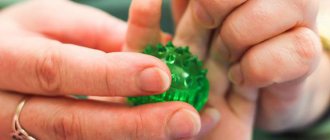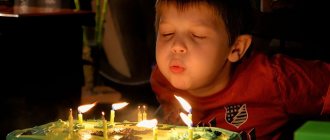Features of speech development in preschool childrenpresentation
Slide 1
Features of speech development in preschool children
Slide 2
Preschool age is a period of active acquisition by a child of spoken language, the formation and development of all aspects of speech - phonetic, lexical, grammatical.
A preschool educational institution is the first and most responsible link in the general system of public education. Mastery of the native language is one of the most important acquisitions of a child in preschool childhood. It is preschool childhood that is especially sensitive to speech acquisition. Therefore, the process of speech development is considered in modern preschool education as the general basis for raising and educating children.
Slide 3
Expanding the circle of communication requires the child to fully master the means of communication, the main one of which is speech.
Slide 4
Main stages of speech development
Russian psycholinguist and psychologist Alexey Leontiev identified several important periods of speech development through which every baby goes.
- The preparatory stage lasts from birth to one year, divided into three periods:
- Crying is the only way a newborn can interact with the outside world and the first vocal reaction. With its help, the baby not only signals to his mother that he feels discomfort, but also trains breathing, voice and articulation;
- humming (up to 6 months) is the baby’s reproduction of certain sounds and their various variations: boo-oo-oo, a-gu, a-gy, etc. Psychologists call the baby during this period a musician who tunes his instrument. It is very important to support the child’s desire to communicate by speaking and repeating “what your child has said”;
- babbling (up to one year) is the final stage of preparing the baby for full speech. Now the baby begins to pronounce syllables, for example, “pa”, “ba”, which are associated with certain people. “Ma-ma,” says the child, addressing his mother.
- The preschool stage begins with the appearance of the first words (usually from 12 months) and ends at the age of three.
Children's first words are of a generalized nature. For example, with the word “give” the baby denotes an object, his desires, and a request. That’s why only close people understand the baby and only in a specific situation.
From the age of one and a half, children learn to pronounce words in full, and not in a truncated form. The vocabulary continues to grow, the child puts together small sentences without prepositions: “Katya kitty” (Katya has a cat), “Katya am-am” (Katya wants to eat).
By the age of three, questions appear in children’s speech: “Where?”, “Where?”, “When?”. The baby begins to actively use prepositions, learns to coordinate words in number, case and gender.
- The preschool stage of speech development lasts from three to seven years. At this time, the volume of active and passive vocabulary increases significantly. If children of the fourth year of life often use simple sentences in speech, then by the age of five they already communicate in compound and complex sentences. And by the end of the preschool stage, children usually pronounce sounds correctly, construct sentences correctly and have a broad outlook.
Slide 5
Characteristics of speech of children of the first junior group
Vocabulary: A child's active vocabulary reaches approximately 1000–1500 words. He gets acquainted with the various properties of objects, establishes the simplest connections between them. Grammatical structure: Children master basic grammatical structures, try to construct simple sentences, and use almost all parts of speech when talking with adults. Children begin to express elementary judgments about objects and simple phenomena. Sound pronunciation: By the age of 3, the so-called physiological softening disappears from the child’s speech. The child correctly reproduces vowels and all simple consonant sounds ([b], [b'], [p], [p'], [m], [m'], [t], [t'], [n], [n'], [k], [k], [g], [g'], [v], [v'], [f], [f']). The main task for children of this age is to develop the articulatory apparatus (carrying out articulatory gymnastics) and to attract attention to the sounding word.
Slide 6
Characteristics of the speech of children of the second younger group.
Vocabulary: Vocabulary of 1500-1900 words, consisting mainly of nouns and verbs. Adjectives and adverbs gradually appear, including words denoting temporal and spatial concepts. The concept of generalizing words begins to form. Grammatical structure: Improves the use of extended sentences. Children master grammatical forms: plural, v.p. and R.p. noun, change the stem of the verb. Connected speech: A simple form of dialogue is available to preschoolers. Tells about what he saw in 2-4 sentences. Listens to long fairy tales and stories. Sound pronunciation: The child correctly pronounces the whistling sounds [s], [s'], [z], [z'].
Slide 7
Characteristics of the speech of children of the middle group.
Dictionary:
A child's active vocabulary reaches 1900-2000 words. In children's speech, the number of abbreviations, rearrangements, and omissions decreases. The child names animals and their young, people’s professions.
Grammar structure:
Children use a more complicated and common phrase.
There are compound and complex sentences, prepositions are used: by, before, instead of, after. Unions: what, where, how much. Completes verbal tasks with prepositions: behind, between, next to. Executes three consecutive commands. Understands conditional sentences with the words “if”.
Connected speech:
Speech becomes more coherent and consistent. Children learn to answer questions, retell well-known fairy tales, stories (with the help of adults).
Sound pronunciation:
By the age of five, almost all age-related irregularities in pronunciation disappear. The sounds [L] and [R] may remain distorted.
Slide 8
Characteristics of the speech of children in the older group. Dictionary:
The child’s vocabulary increases to 2500-3000. A child can give several characteristics of one object (the cat is striped, soft, fluffy, purring). Generalizing words appear in the active dictionary; children correctly name a wide range of objects and phenomena. Grammar structure:
In children, the number of simple common as well as complex sentences increases. When forming a phrase, the child uses all the main parts of speech.
Connected speech:
Children retell stories, fairy tales, and share their own impressions. Sound pronunciation:
Normally, by the age of six, a child masters all the sounds of his native language and uses them correctly in speech. Able to notice peculiarities of pronunciation in other children and some shortcomings in his own speech.
In a child’s speech, as a rule, there are no omissions or rearrangements of syllables and sounds. The only exceptions are certain difficult and unfamiliar words (excavator).
Slide 9
Characteristics of the speech of children in the preparatory group.
Dictionary:
The child's vocabulary increases to 3000-3500 words. The active dictionary is growing rapidly. Children actively use both specific and generic concepts, antonyms, and synonyms. Classify objects.
Grammar structure:
Children learn the basic patterns of changing words and combining them into sentences.
They must use simple prepositions (in, on, from) and complex prepositions (because of, from under, around, near).
Correctly agree in parts of speech (nouns with adjectives, verbs, singular and plural numerals) (For example: Masha and Sasha do not have two ripe apples. The children ate them for lunch.)
Form words using prefixes and suffixes, as well as adverbs from adjectives (fast - quickly), form comparative degrees of adjectives (long - longer - longest), form verbs of motion with prefixes (walked around, came in, came).
Connected speech:
Children must fully understand speech addressed to them.
Understand complex, ambiguous texts.
They can independently compose descriptive stories, detailed and logical in content, and retell fairy tales.
It is logical to express your thoughts using complex sentences with the conjunction “A”.
Sound pronunciation:
Under conditions of correct speech perception and in the absence of organic deficiencies, by the age of six, a child masters all the sounds of his native language and uses them correctly in speech. At this age, almost all children are ready to accept work in preparation for learning to read and write. Correctly distinguish sounds by ear, come up with words for a given sound, or with a given sound. Isolate sounds from words, from a number of syllables and sounds.
Pronounce complex words with a consonant cluster consisting of three or more syllables (defender, motorcyclist), determine the number of syllables in a word.
Slide 11
Standard requirements for the results of mastering the program
Slide 12
The goal of speech development of preschoolers
formation of oral speech and verbal communication skills with others based on mastery of the literary language.
Slide 13
Let's analyze the tasks of speech development:
— Mastery of speech as a means of communication
Teaching a child to speak as a means of communication and culture is the main task. This means that it is necessary to form children’s oral speech at such a level that they do not experience difficulties in establishing contacts with peers and adults, so that their speech is understandable to others. We form the correct oral speech of children on the basis of their mastery of the literary language of the Russian people. Therefore, it is so important that the child hears such speech, so that he feels that he is also heard, and is always ready to interact with him.
— Enrichment of the active dictionary
Mastering your speech means, firstly, mastering your vocabulary. The enrichment of a preschooler’s active vocabulary occurs at the expense of the basic vocabulary of the language and depends on our dictionary and the dictionary of the parents. To expand children's vocabulary, favorable conditions are created through complex thematic planning of work. For example, if we are now implementing the theme “Winter,” then the children’s vocabulary should be replenished and activated within the framework of this theme.
— Development of sound culture of speech
— Development of coherent speech
The child masters speech, starting with the sound structure of the language. Each child has their own rate of learning sounds, but by the age of five, almost every healthy preschooler has the foundation to clearly and distinctly pronounce all the sounds of their native language. In the Federal State Educational Standard, the implementation of this task is called “Development of sound and intonation culture of speech, phonemic hearing” and assumes that the child learns the intonation structure of his native language, the stress system, the pronunciation of words and the ability to speak expressively and read poetry. Our coherent speech consists of two parts - dialogue and monologue. The building material for it is the dictionary and mastering the grammatical structure of speech. Grammatical structure is the ability to change words and combine them into sentences; a child learns by ear, comprehending the speech of adults. In addition, you can conduct special speech exercises to help children learn the most complex structures. For example, the games “What would be…” (learning the subjunctive mood), “What’s missing?” (use of nouns in the genitive case), etc.
— Development of speech creativity
Developing speech creativity is not an easy job. It assumes that children independently compose simple short stories, take part in composing poetic phrases, come up with new twists in the plot of a fairy tale, etc. All this becomes possible if we create the conditions for it.
— Introduction to fiction
Acquaintance with fiction and book culture means understanding by ear the texts of various genres of children's literature. The main problem here is that books have ceased to be a value in many families; children do not gain the experience of reading and listening at home. Therefore, we, preschool teachers, are faced with a very serious task to change the situation here, in a preschool institution: the book should become a companion for children, fill their leisure time, come to life in dramatizations and dramatization games. The artistic word should sound constantly.
— Formation of sound analytical-synthetic activity
And another task of speech development is the formation of sound analytical-synthetic activity as a prerequisite for learning to read and write. All our work on speech development in kindergarten prepares the child for school, where correct oral speech, the ability to listen to others, and delve into the content of their speech are necessary. Already in kindergarten, speech becomes the subject of analysis for children, which poses a serious difficulty for them due to the peculiarities of their thinking.
So, we have identified 7 main tasks of children’s speech development. They are implemented in all groups throughout the entire period of children’s stay in kindergarten, and not only during educational activities. The educational area “Speech Development” closely integrates with each of the four remaining areas, and this interpenetration contributes to the formation of higher mental functions and helps solve problems of social-personal, artistic and physical development.
Slide 14
Directions of work on speech development
1. Development of vocabulary: mastering the meanings of words and their appropriate use in accordance with the context of the statement, with the situation in which communication takes place.
Slide 15
2. Nurturing the sound culture of speech: developing the perception of sounds of native speech and pronunciation
3. Formation of grammatical structure: Morphology (changing words by gender, number, cases) Syntax (mastering various types of phrases and sentences) Word formation
4. Development of coherent speech: Dialogical (conversational) speech Monologue speech (storytelling)
Slide 16
5. Formation of sound analytical-synthetic activity as a prerequisite for learning to read and write
6. Fostering love and interest in artistic expression
Children's literature is fiction, non-fiction and popular science works written specifically for children - from preschool to high school age.
Slide 17 “A person’s morality is visible in his attitude to the word” L.N. Tolstoy
Presentation “Speech development in preschool children”
Natalya Astafieva
Presentation “Speech development in preschool children”
Slide number 1 - splash screen
Dear parents, grandparents!
Of course, you want your children and grandchildren to speak correctly and beautifully, so that they study successfully in school without experiencing difficulties. It's no secret that while studying in primary school, a child has difficulties, especially in mastering the Russian language. What is this connected with? This is due to an insufficient level of speech development . Many children have difficulty constructing phrases, cannot formulate sentences grammatically correctly, have a poor vocabulary, and have impaired sound pronunciation.
Such shortcomings are not noticeable at home, but are revealed in lessons at school. In order to prevent these difficulties, it is necessary to develop the child's speech in preschool age .
Slide number 2
It is important to remember that it is during the preschool period that a child’s speech develops most intensively , and most importantly, it is the most flexible and pliable. Therefore, all speech are overcome more easily and quickly.
Slide number 3 - splash screen
Starting from the earliest years of life, a child’s speech develops by imitation , so the clear, leisurely, grammatically and phonetically correct speech of adults plays a large role in its formation.
Some parents are biased in assessing their child's speech . Often in families, adapting to the baby’s language, they babble with him for a long time, distorting words, imitating children’s speech, as they say, lisp.
Such a manner of communication not only does not stimulate the child to master the correct ones. sound pronunciation, but also perpetuates its shortcomings for a long time. And this is absolutely unacceptable!
In the family, it is necessary to create conditions for the child in which he will experience satisfaction from communicating with adults, not only receive new knowledge from them, but also enrich his vocabulary, learn to construct sentences correctly, pronounce sounds and words correctly and clearly, and tell interesting stories. .
Children's books play an important role in the development of a child's speech They must correspond to his age and be understandable. You should not limit your child to just passively listening to what you read. From time to time it is useful to interrupt your reading with a discussion of what you have heard.
Slide number 4
The concept of "speech"
very extensive.
Each of its most important components - sound pronunciation, vocabulary, grammatical structure and developed coherent speech - is inseparable from the other. All of them are formed in close interconnection. Underdevelopment of one of them often leads to underdevelopment of the other .
Let us dwell in more detail on one of the most important components of speech - sound pronunciation .
A child’s competent, clear and rhythmic speech is characterized by the correct pronunciation of sounds.
Slide number 5
Correct pronunciation of sounds is ensured by good mobility and differentiated functioning of the organs of the articulatory apparatus (tongue, lips, palate, etc.)
Articulatory gymnastics helps to develop clear and coordinated movements of the organs of the articulatory apparatus.
Slide number 6 - splash screen
We bring to your attention some articulatory gymnastics exercises with which you can master the norms of sound pronunciation
Slide No. 7- 11
Each articulatory gymnastics exercise has its own name. These names are conventional, but it is important that children remember them.
Slide number 12
Remember! If a child speaks without opening his lips, or during speech his tongue is not mobile enough, is sluggish, or lies at the bottom of the mouth, high-quality pronunciation will not work.
Slide No. 13
Articulatory gymnastics not only develops the child’s speech apparatus, but also prevents the occurrence of certain speech disorders.
Slide number 14 splash screen
It has been established that in order to master correct sound pronunciation, it is necessary not only to have a sufficiently prepared articulatory apparatus, but also to be able to listen well, to hear, to distinguish between correct and incorrect pronunciation of sounds in someone else’s and one’s own speech , to control one’s own pronunciation, to differentiate sounds: voiced and voiceless consonants (b-p , d-t, soft and hard whistling and hissing (s-z, s-sh, sh-zh, s-s, etc., that is, the child must have developed phonemic hearing .
Slide No. 15
Slide number 16
Phonemic hearing - the ability to perceive by ear and accurately differentiate (discriminate)
all
speech .
By the age of 4-5 years, a child should normally be able to distinguish all speech .
Slide No. 17
Well- developed phonemic hearing in combination with articulation exercises contributes to faster acquisition of correct sound pronunciation in general.
Speaking about sound pronunciation, it should be taken into account that a child at 1-2 years old needs to pronounce the following sounds: a o ep b m;
At 2-3 years: i y u f v t d n g k x y;
At 3-4 years: s z z w w h sch;
At 4-5 years old: r l
Slide number 18
The table shows that by the age of 4-5 years a child should master the correct pronunciation of all speech . Distorted pronunciation of sounds by preschoolers under 4-5 years old is considered normal and is called an age-related or physiological disorder.
And only after 4-5 years, a violation of sound pronunciation is a pathology.
Slide number 19 – splash screen
Thus, it is from this age speech development needs to begin .
Slide No. 20
Incorrect pronunciation of sounds brings children a little grief and difficulty: they are embarrassed by their speech , feel insecure, become shy, withdrawn, have difficulty communicating with others, and suffer ridicule painfully.
Slide number 21 – splash screen
If at preschool age a child has not developed correct sound pronunciation and intelligibility of speech , then at school age increase significantly .
The child will begin to complete words when answering the teacher and when communicating with peers, will cope poorly with the sound analysis of words, will write as he speaks, and will have difficulty reading.
Attention and memory will begin to suffer, behavioral problems will appear - aggressiveness or lethargy, lethargy. Of course, this will affect the child’s interest in learning, his character, will interfere with the assimilation of the school curriculum, and will cause poor performance. Problems can be avoided if due attention is paid to correcting impaired sound pronunciation in time, in preschool age .
Providing speech therapy assistance is almost impossible without the participation of parents.
One of the important responsibilities of parents whose children study with a speech therapist is to continue speech therapy work with the child at home, i.e., doing homework.
For automation (fixing)
We often use the correct pronunciation of sounds and the formation of phonemic hearing in classes and we highly recommend the following tasks.
As you remember, phonemic hearing is the ability to perceive by ear and accurately differentiate (discriminate)
all
speech .
Slide number 22
Tasks for the development of phonemic hearing.
Slides No. 23-28
The use of tongue twisters and tongue twisters has a great effect in speech therapy work.
Excellent exercises for practicing correct, clear speech . They develop phonemic awareness and diction, enrich their vocabulary.
Slides No. 29-30 Pure sayings
Slides No. 31-32 Tongue twisters
Slide number 33 - splash screen
Speech, a wonderful gift of nature, is not given to a person from birth. It will take time for the baby to start talking. And we, adults, must make a lot of effort to ensure that the child’s speech develops correctly and in a timely manner, that is, it is very important to help master this wonderful gift as successfully as possible.








